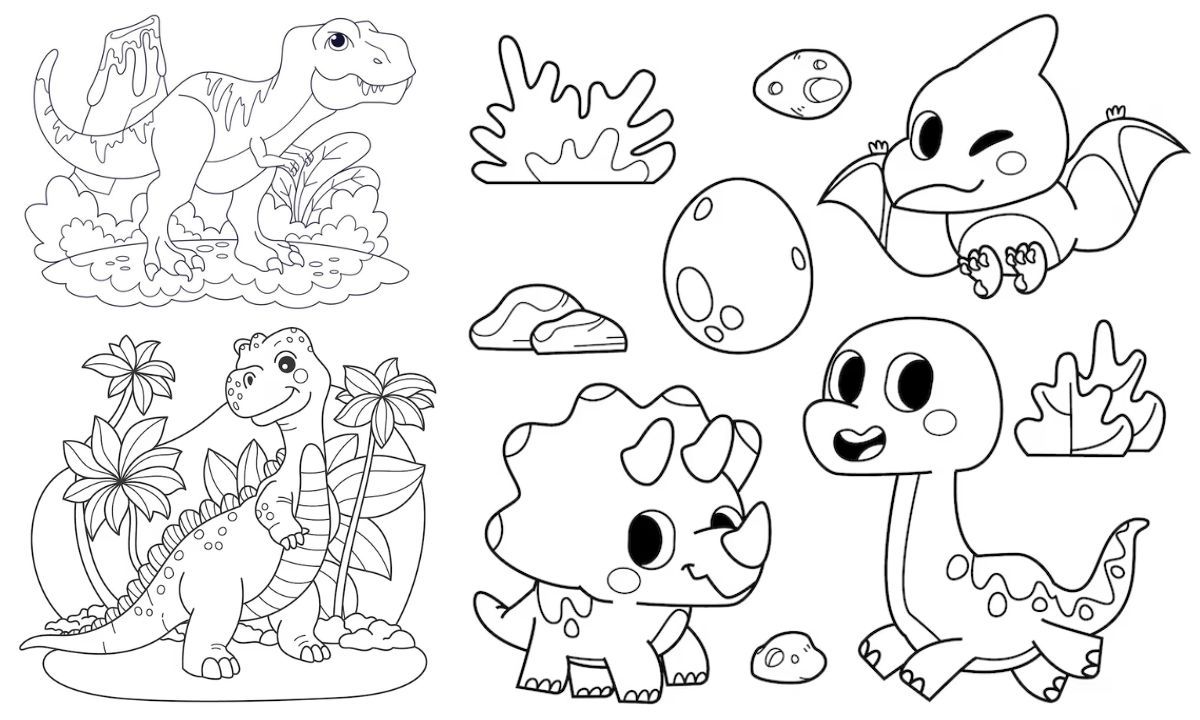Are you searching for charming prehistoric creatures to sketch without needing professional art skills? Look no further! This collection of adorable dino sketches will transform anyone into a dinosaur artist in no time. These easy dinosaur drawing tutorials are perfect for parents helping dino-obsessed kids, teachers planning creative classroom activities, or anyone who simply loves these fascinating extinct reptiles.
Whether you’re a complete beginner or someone looking to expand your prehistoric art repertoire, these 22 simple dino sketches will bring joy to your drawing sessions. Most require just basic supplies – a pencil, paper, and perhaps some colors to bring your friendly dino creations to life. Let’s grab our sketching tools and journey back to the Jurassic period through art!
A Simple Standing Dinosaur
The perfect starting point for any aspiring dinosaur artist is a basic standing dinosaur. This upright dino uses fundamental shapes that anyone can master – circles for the body and head, triangles for spikes, and simple lines for legs and tail.
To create this vertical dinosaur, follow these beginner-friendly steps:
- Draw a large oval for the body, tilted slightly upward
- Add a smaller circle for the head
- Connect them with a curved neck line
- Draw two triangle shapes for back legs and smaller ones for arms
- Add a long, tapering tail
- Finish with simple facial features – dots for eyes and a curved line for a smile
What makes this tall dinosaur particularly charming is its simplicity. You can add personality with just a few small tweaks to the eyes or mouth. Many beginners find success with this bipedal reptile design because it captures the essence of dinosaurs without overwhelming details.
“The simplest drawings often carry the most charm. A basic standing dinosaur allows children to feel successful while learning fundamental drawing skills.” – Elementary art teacher Amy Rodriguez
Smiling Baby Dinosaur
Nothing captures hearts quite like a baby dinosaur with a cheerful expression! This infant dino design emphasizes adorable proportions – a larger head relative to body size, rounded features, and big expressive eyes that scream cuteness.
To draw this young dinosaur, focus on:
- An oversized round head (nearly half the drawing’s total size)
- Stubby, short limbs that look slightly unsteady
- Large, bright eyes placed high on the face
- A wide, open-mouthed smile
- Optional: tiny teeth or a visible tongue for extra charm
- Small, undeveloped spikes or plates if drawing a specific species
What makes this tiny reptile particularly successful as a drawing subject is the universal appeal of baby proportions. Even fierce dinosaurs become adorable when given the “baby treatment” with larger eyes and heads. This hatchling dinosaur approach works for virtually any species – from T-Rex to Stegosaurus.
A Cute Triceratops
The distinctive three-horned face and protective frill make the adorable triceratops instantly recognizable, even when simplified. This horned dinosaur combines unmistakable features with a friendly expression for maximum appeal.
To create your friendly triceratops:
- Start with an oval body, slightly larger toward the rear
- Add a triangular head with the point facing forward
- Attach the characteristic frill as a half-circle behind the head
- Place three small triangular horns – one on the nose and two above the eyes
- Draw four sturdy legs underneath (triceratops walked on all fours)
- Add round, gentle eyes and a small smiling mouth
- Finish with some simple texture lines on the frill if desired
What makes this small triceratops particularly appealing is the contrast between its naturally armored appearance and the friendly expression we give it. Children especially love how recognizable this dinosaur is while still being simple enough to draw successfully.
Did you know? Triceratops horns weren’t primarily for fighting predators – they were likely used more for competing with other triceratops and for display!
A Flying Dinosaur
While technically pterosaurs weren’t true dinosaurs (they were flying reptiles that lived alongside dinosaurs), no dinosaur drawing collection would be complete without these magnificent prehistoric flyers. This winged reptile design simplifies the complex anatomy while maintaining the distinctive silhouette.
To sketch this soaring dinosaur:
- Draw a small oval body
- Add a long, narrow head with a pointed beak
- Create one large wing extending from each side (triangular shapes work well)
- Add thin, elongated legs trailing behind
- Draw a long, pointed tail if including a rhamphorhynchus type
- Place a small crest on the head for certain species
- Finish with a simple eye and mouth
What makes these airborne dinos particularly engaging to draw is the dramatic wingspan and dynamic poses possible. Try drawing them from different angles – soaring overhead, gliding above water, or perched on a cliff. This versatility makes them a favorite prehistoric art subject.
| Pterosaur Type | Key Features | Wingspan | Drawing Difficulty |
| Pteranodon | Long head crest, toothless beak | Up to 6 meters | Medium |
| Pterodactylus | Shorter head, teeth, short tail | 1-1.5 meters | Easy |
| Rhamphorhynchus | Long tail with diamond tip, teeth | 1-2 meters | Medium-Hard |
| Quetzalcoatlus | Enormous size, long neck | Up to 10 meters | Medium |
A Gentle Tyrannosaurus
Transforming the king of dinosaurs into a kind T-Rex might seem contradictory, but it creates a delightful contrast that children especially enjoy. This friendly tyrannosaur maintains the recognizable T-Rex silhouette while softening the traditionally fierce features.
To create your gentle dino:
- Draw a large oval body leaning forward
- Add a substantial rectangular head with a rounded snout
- Include the characteristic tiny arms
- Draw powerful hind legs with three-toed feet
- Add a long, thick tail for balance
- Most importantly: give it friendly, round eyes and a gentle smile instead of a fearsome grimace
- Optional: add small, non-threatening teeth or even a tongue sticking out playfully
What makes this soft T-Rex particularly successful is playing with the contrast between our expectations of the ferocious predator and the charming, friendly version we create. Children find these calm tyrannosaurus drawings especially appealing because they transform something potentially scary into something lovable.
Fun fact: Despite their fearsome reputation, real T-Rex arms were surprisingly weak and couldn’t even reach their mouths!
Standing Dinosaur Looking Up
Adding a simple pose change creates interest in your standing T-Rex drawings. This variation shows curiosity as your upright dino cranes its neck to look at something overhead – perhaps a prehistoric flyer or the night sky.
Create this inquisitive pose by:
- Starting with the basic standing dinosaur shape
- Extending the neck upward and slightly backward
- Positioning the head with the snout pointing toward the sky
- Adding slightly bent knees to suggest the shifting weight
- Drawing the tail lower to balance the pose
- Creating an expression of wonder with wide eyes and a slightly open mouth
This pose introduces simple body language to your dinosaur illustrations, teaching an important artistic concept while maintaining an easy-to-draw approach. The slight change in position adds storytelling to your drawing – what is your dinosaur looking at? What has caught its attention?
“Teaching children to add narrative elements to their drawings through simple pose changes helps develop both artistic and storytelling skills simultaneously.” – Children’s book illustrator Mark Thompson
Dinosaur Looking at The Stars
Building on the previous concept, this stargazing scene creates a surprisingly emotional moment. Your vertical dinosaur silhouette against a starry background evokes wonder and contemplation – perfect for a more artistic dinosaur drawing.
To create this nighttime scene:
- Draw a simple dinosaur profile with neck extended upward
- Create a clean silhouette by filling in the dinosaur shape with solid black or dark blue
- Add a deep blue or purple background
- Dot the background with stars of various sizes
- Consider adding a crescent moon or shooting star for extra interest
- For advanced options: add a slight reflection below to suggest water
This drawing teaches important artistic concepts like silhouettes and negative space while remaining an easy prehistoric illustration. The emotional quality of this drawing makes it particularly suitable for bedroom decorations or story illustrations.
A Simple Pterodactyl
This basic pterodactyl focuses on clean lines and minimal details for an elegant, easy-to-create flying reptile. Unlike our earlier flying dinosaur that emphasized dynamic movement, this simple prehistoric flyer captures the essence of pterosaurs with fewer lines.
For this quick pterosaur sketch:
- Draw a small oval head with a pointed beak
- Add a tiny body – much smaller than most people realize
- Create one long finger extending from each side to support the wing membranes
- Draw simple membrane shapes connecting to the body and legs
- Add small hind legs
- Keep details minimal – just an eye and mouth line
- Use clean, confident lines for an elegant look
This easy flying dinosaur works particularly well in a minimalist style. Consider drawing it as a simple outline against a colored background, or as part of a prehistoric landscape silhouette. The clean lines make this beginner pterodactyl design suitable for various craft projects beyond paper – try it on rocks, fabric, or even as a simple wall decoration.
A Dancing Dinosaur
Inject some personality and joy into your prehistoric pals with this playful dinosaur caught mid-dance! This fun dino celebrates movement and expression, creating an instantly engaging character that appeals to all ages.
To create your energetic reptile:
- Start with a basic dinosaur shape, but position it on one leg
- Raise the other leg in a kicking or stepping motion
- Lift the arms in different directions as if dancing
- Tilt the head slightly with an expression of joy
- Consider adding movement lines around the limbs
- Position the tail for balance or as part of the dance motion
- Add details like a party hat, bow tie, or small radio for extra humor
This lively dino teaches simple principles of showing movement in drawings while maintaining an accessible level of difficulty. The mischievous dinosaur concept works particularly well for birthday cards, invitations, or any project needing a touch of whimsy and celebration.
Creative variation: Create a dinosaur dance party with multiple species all showing different dance moves!
A Cute Stegosaurus
The distinctive plates and tail spikes of this herbivore become adorable features in our adorable stegosaurus design. This small plated dinosaur simplifies the complex anatomy while preserving the instantly recognizable profile.
To draw this friendly stegosaurus:
- Create an oval body that arches slightly in the middle
- Add a very small head with a gentle expression
- Draw four stumpy legs – stegosaurus had relatively short limbs
- Add a series of triangular plates along the spine – don’t worry about perfect placement
- Include four spikes on the tail (these were called the “thagomizer”!)
- Keep the head simple with just eyes and a tiny smile
- Optional: add some texture to the plates with simple lines
What makes this spiky reptile particularly charming is transforming what were defensive features into cute decorative elements. Children enjoy the distinctive look of this dinosaur, and the repetitive shapes of the plates make it a good practice for creating patterns.
| Stegosaurus Feature | Real Purpose | How to Make it Cute |
| Back Plates | Heat regulation and display | Make them rounded, colorful, or flower-shaped |
| Tail Spikes | Defense against predators | Draw them smaller, rounder, or with decorative patterns |
| Small Head | Adapted for low vegetation | Add large, expressive eyes and a sweet smile |
| Bulky Body | Digestive system for plants | Round it out to look pleasantly plump rather than imposing |
Another Kind of Stegosaurus
Offering a different perspective on the same species shows how artistic choices affect the final drawing. This alternative charming dino view presents the stegosaurus from a different angle or stylistic approach.
For this variation:
- Try a side view instead of three-quarter view
- Experiment with plate arrangements – maybe a double row or different sizes
- Consider showing just the head and part of the body for a close-up portrait
- Add some personality with accessories like a flower behind the ear or glasses
- Play with proportions – perhaps an extra-long tail or particularly emphasizing the plates
- Try a more cartoonish style with exaggerated features
This exercise demonstrates how the same subject can look entirely different with just a few artistic choices. It’s a valuable lesson in developing your personal drawing style while working with recognizable subjects.
A Flying Pterodactyl
Unlike our earlier, simpler pterosaur, this version focuses on capturing dynamic movement and the grace of prehistoric flight. This gliding dinosaur design emphasizes the dramatic wingspan and aerial capabilities.
For a more dynamic prehistoric flyer:
- Position the body at an angle as if in mid-flight
- Draw the wings with one more extended than the other to suggest turning
- Create more detailed wing membranes with slight wrinkles or texture
- Position the head looking in the direction of travel
- Add wind lines or clouds around the figure to suggest movement
- Draw the legs pulled up against the body aerodynamically
- Consider the perspective from below, as if we’re watching it soar overhead
This winged reptile drawing introduces more advanced concepts like foreshortening and dynamic poses while still using relatively simple shapes. The dramatic nature of flight makes even beginner attempts look impressive when basic principles of movement are applied.
Did you know? Pterosaurs weren’t actually dinosaurs! They were flying reptiles that lived alongside dinosaurs but belonged to a different reptile group entirely.
A Cooking Dinosaur
Anthropomorphizing prehistoric creatures creates instant charm and humor. This whimsical concept shows a dinosaur engaged in the very human activity of cooking, creating a delightful juxtaposition.
To create this culinary playful T-Rex:
- Draw your dinosaur of choice standing upright
- Add a chef’s hat or apron (or both!)
- Place cooking tools in hand – perhaps a spoon or spatula (particularly funny with T-Rex’s tiny arms)
- Position near a stove or with a cooking pot
- Add details like a recipe book, ingredients, or steam from cooking
- Create a concentrated expression as they focus on their culinary creation
- For extra humor, consider what a dinosaur might cook (enormous eggs? prehistoric plants?)
This fun dino concept teaches valuable lessons about using unexpected elements to create humor in art. The contrast between the prehistoric creature and the modern human activity creates an instantly engaging character that sparks imagination.
Creative activity: Have children create menus for their cooking dinosaur’s restaurant!
A Gentle Brachiosaurus
The iconic long-necked silhouette of this massive herbivore makes a perfect subject for simplified dinosaur art. Our gentle dino approach emphasizes the graceful proportions and peaceful nature of this magnificent creature.
To draw your kind brachiosaurus:
- Create a large oval body with sturdy, column-like legs
- Draw the famously long neck extending upward and slightly curved
- Add a relatively small head at the top
- Include the characteristic small hump on the back
- Draw a long, tapering tail to balance the neck
- Add gentle eyes and a content expression
- Keep the overall lines smooth and flowing to emphasize the graceful nature
What makes the brachiosaurus particularly appealing as a drawing subject is the distinctive silhouette that remains recognizable even when highly simplified. The peaceful, plant-eating nature of this dinosaur also makes it an appealing character for children who might be intimidated by more aggressive species.
Fun fact: Brachiosaurus could stand as tall as a four-story building and might have used its long neck to reach high tree branches that other dinosaurs couldn’t access.
A Cute Parasaurolophus
The distinctive curved crest of this hadrosaur becomes an adorable feature in our simplified design. This duck-billed dinosaur’s most recognizable feature makes it a unique addition to your dinosaur illustrations collection.
For your cute parasaurolophus:
- Draw an oval body with strong back legs and smaller front legs
- Create the characteristic duck-bill shaped mouth
- Add the curved tube-like crest extending backward from the head
- Draw gentle, expressive eyes on the side of the head
- Include a medium-length tail
- Add minimal details to keep it approachable for beginners
- Consider making the crest decorative with patterns or colors
The unusual head shape of this dinosaur creates instant recognition while offering opportunities for creative decoration. The crest can be colored, patterned, or even given a hollow tube-like appearance to reference its suspected use as a resonating chamber for making sounds.
Science connection: Scientists believe the parasaurolophus crest may have been used to make distinctive calls, almost like a prehistoric trumpet! You can mention this fascinating fact when creating this drawing.
A Parasaurolophus with Wings
Venturing into fantasy territory, this imaginative variation adds wings to create a unique hybrid creature. While not scientifically accurate, this creative approach encourages thinking beyond the constraints of reality.
To create this fantasy dinosaur:
- Start with the basic parasaurolophus shape from the previous drawing
- Add large bird-like or bat-like wings extending from the shoulders
- Consider how the wings connect to the body in a way that looks somewhat plausible
- Position the wings either spread wide or partially folded
- Add details like feathers or wing membranes depending on your wing type
- Ensure the dinosaur’s expression looks suitable for flight – perhaps excited or peaceful
- Optional: add motion lines or clouds to suggest it’s actually flying
This exercise is valuable for teaching creative thinking and the concept that art doesn’t always have to adhere to scientific accuracy. Fantasy creatures combine familiar elements in new ways, stimulating imagination while still building on drawing skills learned from realistic subjects.
Baby Dino in its Egg
Few concepts capture the “aww” factor quite like a hatching baby dinosaur. This infant dino design focuses on the moment of emergence, creating an instantly endearing scene.
To draw this young dinosaur:
- Start with an egg shape – either whole with cracks or partially broken
- Show the baby dinosaur partially emerging – perhaps just the head and tiny arms
- Make the baby’s features extra cute – oversized eyes, tiny teeth or beak
- Add cracks and fragments around the emerging parts
- Consider adding tiny details like egg tooth (many reptiles have a temporary “tooth” used to break out of eggs)
- Draw the baby with an expression of wonder or curiosity at its new world
- Optional: add a nest made of simple crossed lines to represent twigs
This hatchling dinosaur scenario teaches important concepts about telling a story through a single image. The moment of hatching captures a dramatic life transition that even young artists can relate to and appreciate.
Creative extension: Create a series showing the baby before, during, and after hatching for a complete narrative sequence.
A Swimming Dinosaur
Not all dinosaurs stayed on land! This aquatic-themed design shows how to create the impression of water and swimming motion with simple techniques. Perfect for expanding beyond typical dinosaur poses.
For your aquatic creature:
- Choose a plesiosaur or other marine reptile with flippers (technically not dinosaurs, but commonly grouped with them in children’s materials)
- Position the body in a curved, swimming motion
- Draw flippers extended as if paddling
- Add simple wave lines around the figure
- Include bubbles rising toward the surface
- Draw the head either above or below the water line
- Consider adding fish or underwater plants for context
While true dinosaurs weren’t aquatic (those were separate marine reptiles), this drawing expands the prehistoric reptile repertoire and teaches valuable techniques for showing interaction with environments. The fluid nature of water allows for dynamic poses that look impressive even with simple execution.
Scientific note: You can mention that animals like plesiosaurs, mosasaurs, and ichthyosaurs were marine reptiles that lived alongside dinosaurs but weren’t technically dinosaurs themselves.
A Ferocious Dinosaur
Even “ferocious” can be cute with the right stylistic approach! This dinosaur sports playfully angry eyebrows and tiny teeth in a roar that’s more adorable than scary. It’s the perfect balance of fierceness and charm.
To create this joyful prehistoric creature with attitude:
- Choose a typically fearsome dinosaur like T-Rex or Velociraptor
- Draw it in a roaring pose with mouth open
- Add comic-style angry eyebrows (simple downward-angled lines)
- Include small, non-threatening teeth rather than realistic fangs
- Draw the arms or claws in an exaggerated threatening pose
- Keep the eyes large and expressive despite the “fierce” expression
- Consider adding sound effect words like “ROAR!” in bubble letters
This drawing teaches the valuable artistic concept that expressions can be suggested with very simple line changes. The contrast between the “fierce” intent and the cute execution creates humor that children particularly enjoy.
A Giant Dinosaur
Size matters in this perspective-focused drawing that shows a massive dinosaur from a low angle. This technique creates the impression of enormous scale without making the drawing itself more complex.
For your colossal creation:
- Choose a naturally large dinosaur like Brachiosaurus or Apatosaurus
- Position the viewpoint low to the ground, looking up
- Draw the legs coming toward the viewer, getting larger at the bottom
- Show only part of the dinosaur – perhaps just legs and part of the body
- Add small elements for scale comparison – tiny trees, a bird, or a person
- Consider using forced perspective – objects in the foreground much larger than background
- Use strong, bold lines for impact
This drawing introduces important concepts of perspective and scale while remaining accessible to beginners. The dramatic viewpoint creates instant visual interest even with relatively simple dinosaur shapes.
Mathematical connection: Discuss how the largest dinosaurs could weigh as much as 12 elephants and stretch longer than three school buses!
A Playful Dinosaur
Caught in mid-frolic, this energetic reptile radiates joy and playfulness. Movement and expression combine to create a dinosaur full of personality and charm.
To create your lively dino:
- Position your dinosaur in an active pose – perhaps mid-jump or bounce
- Bend the legs to suggest spring and movement
- Draw the tail curved or waving
- Position the head in a joyful tilt
- Create a big smile and expressive, happy eyes
- Add motion lines around the figure
- Consider adding a toy or playmate to enhance the playful theme
This fun dino drawing teaches how simple changes in body position can completely transform the character and emotion of your subject. The dynamic nature of play allows for creative pose experimentation while maintaining the cute aesthetic.
Activity idea: Create a “playground” scene with multiple playful dinosaurs engaged in different activities like sliding, swinging, or playing ball games.
Another Standing Dinosaur
We come full circle with a final standing dinosaur, but with new techniques and details to try. This variation builds on everything learned from previous drawings, creating a more confident and personalized creation.
For this final standing T-Rex:
- Use the basic standing shape from our first drawing
- Add more confident details based on skills developed
- Experiment with different head positions or expressions
- Try adding simple texture like scales or skin patterns
- Consider combining favorite elements from other dinosaurs
- Add environmental elements like ground, plants, or sky
- Sign your masterpiece!
This final drawing provides an opportunity to assess progress and see how far your dinosaur drawing skills have developed. Comparing this to the first standing dinosaur often reveals significant improvement in confidence, line quality, and creative decision-making.
Wrap up
Congratulations! You’ve now mastered 22 adorable dino designs that showcase the charm and diversity of prehistoric creatures. Remember, the key to creating cute dinosaur drawings lies in simplification, emphasizing endearing features, and adding personal touches that make each creation uniquely yours.
These easy prehistoric illustrations demonstrate that anyone can create charming dinosaur art without advanced skills or supplies. The techniques learned – from basic shapes to expressing emotion and showing movement – apply far beyond dinosaur subjects and build fundamental art skills.
Key takeaways from our dinosaur drawing adventure:
- Simple shapes can create recognizable creatures
- Facial expressions dramatically change character
- Positioning and posture convey emotion and story
- Creative license makes drawing more fun and personal
- Practice across different species builds transferable skills
Don’t forget to share your charming reptile creations with friends and family or display them proudly in your home or classroom. These lovable prehistoric pals are sure to bring smiles wherever they go!
What’s your favorite dinosaur to draw? Keep practicing these easy dinosaur drawing techniques, and soon you’ll be creating your own prehistoric pals with confidence and creativity!










